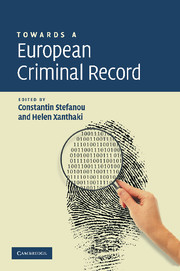Book contents
- Frontmatter
- Contents
- List of contributors
- Preface and acknowledgements
- 1 Introduction: How did the idea of a European Criminal Record come about?
- PART I
- PART II
- 5 The European Criminal Record in Austria
- 6 The European Criminal Record in the Czech Republic
- 7 The European Criminal Record in Germany
- 8 The European Criminal Record in Greece
- 9 The European Criminal Record in Hungary
- 10 The European Criminal Record in Ireland
- 11 The European Criminal Record in the Netherlands
- 12 The European Criminal Record in Slovenia
- 13 The European Criminal Record in Slovakia
- 14 The European Criminal Record in Spain
- 15 The European Criminal Record in England and Wales
- PART III
- 19 Conclusions
- Index
12 - The European Criminal Record in Slovenia
Published online by Cambridge University Press: 13 July 2009
- Frontmatter
- Contents
- List of contributors
- Preface and acknowledgements
- 1 Introduction: How did the idea of a European Criminal Record come about?
- PART I
- PART II
- 5 The European Criminal Record in Austria
- 6 The European Criminal Record in the Czech Republic
- 7 The European Criminal Record in Germany
- 8 The European Criminal Record in Greece
- 9 The European Criminal Record in Hungary
- 10 The European Criminal Record in Ireland
- 11 The European Criminal Record in the Netherlands
- 12 The European Criminal Record in Slovenia
- 13 The European Criminal Record in Slovakia
- 14 The European Criminal Record in Spain
- 15 The European Criminal Record in England and Wales
- PART III
- 19 Conclusions
- Index
Summary
Introduction
Ideas of mutual recognition and mutual trust in connection with a central criminal record authority are not recent. As we know, the need for a more effective exchange of criminal record data was emphasised in the European Council Declaration on Combating Terrorism (March 2004) and confirmed by the Hague Programme (November 2004). In October 2004 the first Proposal for a Council Decision on the exchange of information extracted from criminal records was adopted. It was followed by the White Paper on exchanges of information on convictions and the effect of such convictions within the European Union (January 25 2005) and the Council Decisions on the exchange of information extracted from the criminal record. Among the three possible options for a mutual recognition programme proposed in the White Paper the Commission obviously chose a middle option between networking of national criminal record offices. This solution was presented in the Proposal for a Council Framework Decision on the organisation and content of the exchange of information extracted from criminal records between Member States in December 2005.
The purpose of this chapter is to give an overview of the recent Slovenian legal framework regarding criminal records and the transfer of data from the criminal records. This will be done in order to enquire into the legal obstacles to implementing the last EU document on the topic, namely the Proposal for a Council Framework Decision on the organisation and content of the exchange of information extracted from criminal records between Member States.
- Type
- Chapter
- Information
- Towards a European Criminal Record , pp. 226 - 241Publisher: Cambridge University PressPrint publication year: 2008

